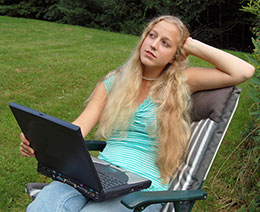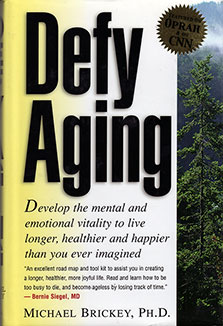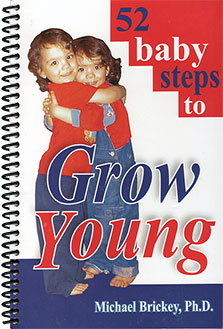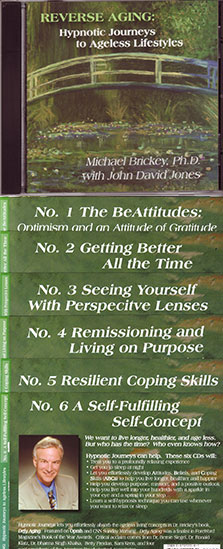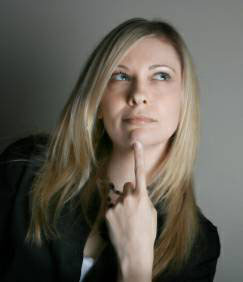The Defy Aging Newsletter
Anti-aging psychology, holistic health, and wellness
These are archives of a biweekly e-mail newsletter for helping you think, feel, look, and be more youthful and live with purpose.
February 21, 2008 Number 182
This issue:
Exercise That Fosters Longevity
Action to take
Consider whether your exercising fits well with living a long, healthy life.
Why
A widely reported British study of twins found that the twin who exercised more had longer telomeres--and the more exercise the longer the telomeres. Under a microscope, telomeres of frequent exercisers looked nine years younger than couch potato telomeres. Telomeres cap the ends of chromosomes and each time the cell reproduces the telomeres shorten. When they get too short, the cell cannot reproduce. The researchers ruled out smoking and marital status as causal factors. (The study is, of course, correlational research and it is possible there could be differences other than exercise.)
The research prompted headlines like, "If you want to live nine years longer a daily jog could do the trick." Personally, I have a lot of reservations about jogging as an exercise of choice.
Good planning starts with the end in mind. The same planning should go with how you exercise. Here are my rules for exercising for longevity:
Rule #1 Be Gentle on Joints
If your long-term outcome is for your knees to last 100+ years, jogging may be a problem. You might be better served by running on a trampoline or soft surface or using an elliptical machine. If you do want to jog (perhaps to get the invigorating feeling of being outdoors, going somewhere, and scenery) be sure to carefully choose your shoes and avoid pavement. If you play a lot of basketball, make sure it isn't unduly compromising your knees. If a sport such as tennis is causing repetitive motion pain, regard it as a wake up call. Extreme weight lifting is very hard on joints.
Rule #2 Avoid Injuries
There are friendly games of touch tag football that are great exercise. And there are aggressive, brutal games like the one in the movie Wedding Crashers. It's not the sport per se but the way you and your colleagues play it that is important. Also consider head injuries. Football, for example, causes a lot of concussions (which cause brain damage and foster senility). If you play soccer, do you really want to head butt balls going as fast as 30 miles an hour? Being objective, what is the likelihood of your becoming injured from sports or exercising in the next ten years?
Rule #3 Foster Flexibility
Most activities, sports, and exercises use our flexor muscles more than our extensor muscles. Flexibility involves making sure we use the extensor muscles as well and keep a good range of motion. This can be as easy as periodically taking a break from the computer and stretching. If your current sports, exercises, and activities don't leave you flexible, consider supplementing them with exercises that enhance flexibility.
Rule #4 Practice Balancing
As people age, many choose to become less active. Consequently, their muscle strength declines, their bones weaken, and their balance declines. Causes of declining balance include not using their proprioceptive system and neurons not being as efficient as they used to be. This is a set up for falling and breaking a hip or another bone. Just spending a few minutes balancing yourself on one leg in various positions helps a lot to slow the decline. This can be done while watching TV or perhaps even while waiting in a line.
Rule #5 Go for Optimal Heart and Lung Capacity
The traditional advice is to get on a treadmill for at least thirty minutes and get into your target heart rate zone (50-85% of your capacity). Dr. Al Sears makes a convincing case that this is actually training our hearts and lungs to have that capacity (but not more). He cites marathon runners as examples of how because of their extreme cardiovascular workout they have little reserve capacity for all out exertion or health crises and are prone to heart attacks. He advocates exercising full out for a couple of minutes and recouping, and then repeating the process a few times. Just as the key to building muscle is to challenge it, the key to a bigger heart and lung muscle is to challenge it and have reserve capacity that can endure an all out expenditure of energy (an emergency or even shoveling snow) or a health crisis such as a heart attack.
Rule #6 Have Good Posture
Other than injuries, the biggest cause of back problems is the long-term effects of poor posture. The solution is often subtle exercises to develop supporting muscles. Experts in this area include movement specialists and Pilates and Feldenkris instructors.
Rules #7 Be Strong
When young, strength feeds energy, confidence, ability and a higher metabolism to counter a creeping waistline. With age and the tendency for bones to lose mass, it becomes increasingly important for bone density to prevent broken bones and osteoporosis. Muscle strength comes more from challenging limits than mere repetition.
Achieving all of these goals is best met by a variety of activities and exercises. You don't have to spend money or join a fitness club to get results. The best exercise equipment is your own body (calisthenics). The second best is a jump rope (on a soft surface). Do consult with your doctor before undertaking any increase in exercise intensity.
Quotes
It used to be said that you’re too old to exercise. Well, the truth is that you're too old not to exercise. Most of what passes as aging really isn’t. It’s disuse.
~Walter Bortz,MD
Humor
I used to watch golf on TV but my doctor told me that I need more exercise, so now I watch tennis.
Reprint this article from:
THE DEFY AGING NEWSLETTER
Anti-Aging Psychology
Holistic Health and Wellness
This newsletter article may be reprinted in E-zines, newsletters, newspapers, and magazines provided the content is not edited and the attribution below is given. Formatting may be changed and you may use one of the web site pictures of the author to accompany the article.
"Dr. Michael Brickey, The Anti-Aging Psychologist, teaches people to think, feel, look and be more youthful. He is an inspiring keynote speaker and Oprah-featured author. His works include: Defy Aging, 52 baby steps to Grow Young, and Reverse Aging (anti-aging hypnosis CDs). Visit www.NotAging.com for a free report on anti-aging secrets and a free newsletter with practical anti-aging tips."

